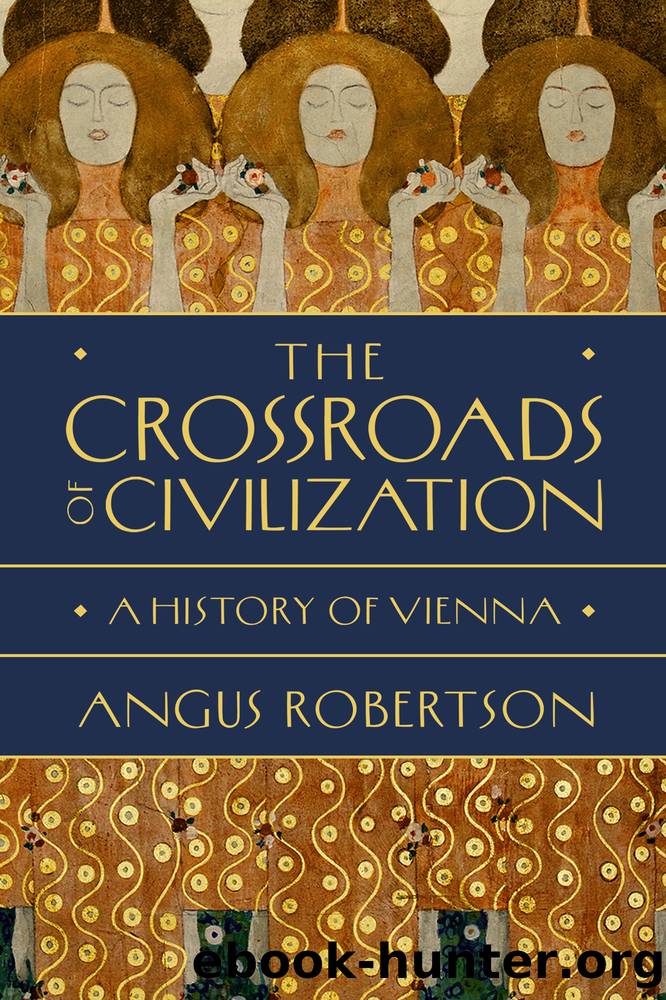The Crossroads of Civilization by Angus Robertson

Author:Angus Robertson
Language: eng
Format: epub
Publisher: Pegasus Books
Published: 2022-08-02T00:00:00+00:00
* * *
The last decade of the 19th century that followed Crown Prince Rudolfâs death and the first decade of the 20th century were characterised by an unparalleled flowering of cultural and creative innovation. Vienna was the world centre of cutting-edge music, art, architecture, design, literature and new thinking about the human condition.
After decades of staid society, conservative politics and constrained tastes, the particular circumstances of Vienna and Austria-Hungary turbo-charged a flowering of talents. In his Pulitzer Prize-winning work Fin-de-siècle Vienna, the cultural historian Carl Schorske explained the period: âVienna in the fin de siècle, with its acutely felt tremors of social and political disintegration, proved one of the most fertile breeding grounds of [the] centuryâs a-historical culture. Its great intellectual innovators â in music and philosophy, in economics and architecture, and of course, in psychoanalysis â all broke, more or less deliberately, their ties to the historical outlook central to the nineteenth century liberal culture in which they have been reared.â53
Prominent among the innovators was a group of creatives who literally declared independence from the old order by establishing the Vienna Secession, a movement and venue for new expression. Established in 1897 by the artist Gustav Klimt, the architects Josef Hoffmann and Joseph Maria Olbrich, designer Koloman Moser, painters Oskar Kokoschka and Egon Schiele and others, it soon led to the construction of the famous Secession Building, designed by Olbrich. A venue to display Secessionist art, the golden-domed gallery is one of the most recognisable buildings in Vienna with its motto âTo every age its art, to every art its freedomâ above the portal. A major driver for the Secession movement was its collaboration with international artists, such as the Scottish modernists Charles Rennie Mackintosh, his wife Margaret Macdonald, and Frances and Herbert MacNair. The âGlasgow Fourâ joined other international artists Max Klinger, Eugène Grasset and Arnold Bocklin in Vienna, having been invited to display their works at the Secession.
Less than 15 minutesâ walk away, the cream of the emerging writing scene was meeting at Café Griensteidl next to the Hofburg palace. The Young Vienna (Jung-Wien) society was heavily influenced by modernist thinking, including impressionism and symbolism. It included Arthur Schnitzler, Stefan Zweig, Karl Kraus, Hugo von Hofmannsthal, Hermann Bahr and Richard Beer-Hofmann, Felix Dörmann and Peter Altenberg. According to Carl Schorske, their shared agenda âchallenged the moralistic stance of nineteenth century literature in favor of sociological truth and psychological â especially sexual â opennessâ.54 In a historic footnote, the group also included the diplomat and keen writer Leopold von Andrian, who worked in the Foreign Ministry in 1914 and was tasked by Foreign Minister Leopold Berchtold to draft the war aims of Austria-Hungary.55
In the Vienna musical scene, Gustav Mahler was the key pivot from the late romantic period to the modern era, not just as a composer but also as conductor of the Vienna Court Opera and Vienna Philharmonic Orchestra. His brother in-law and fellow composer Karl Zemlinsky was a major figure in the period, during which he was conductor at the Carltheater, then Kapellmeister of the Vienna Volksoper and the Court Opera.
Download
This site does not store any files on its server. We only index and link to content provided by other sites. Please contact the content providers to delete copyright contents if any and email us, we'll remove relevant links or contents immediately.
| General | Channel Islands |
| England | Northern Ireland |
| Scotland | Wales |
Room 212 by Kate Stewart(4111)
The Crown by Robert Lacey(4111)
Endurance: Shackleton's Incredible Voyage by Alfred Lansing(3852)
The Iron Duke by The Iron Duke(3642)
The Rape of Nanking by Iris Chang(3522)
Killing England by Bill O'Reilly(3459)
Joan of Arc by Mary Gordon(3263)
Say Nothing by Patrick Radden Keefe(3067)
I'll Give You the Sun by Jandy Nelson(2844)
Hitler's Monsters by Eric Kurlander(2736)
Shadow of Night by Deborah Harkness(2723)
Margaret Thatcher: The Autobiography by Thatcher Margaret(2688)
Mary, Queen of Scots, and the Murder of Lord Darnley by Alison Weir(2680)
Darkest Hour by Anthony McCarten(2650)
Blood and Sand by Alex Von Tunzelmann(2611)
Red Famine: Stalin's War on Ukraine by Anne Applebaum(2467)
Eleanor & Park by Rainbow Rowell(2397)
The One Memory of Flora Banks by Emily Barr(2349)
Book of Life by Deborah Harkness(2269)
